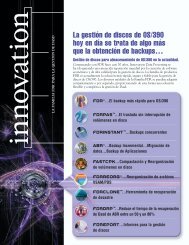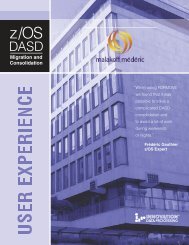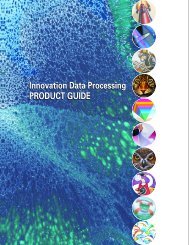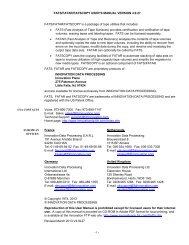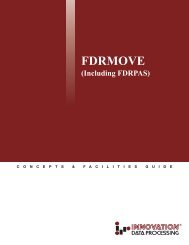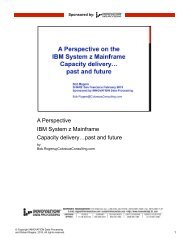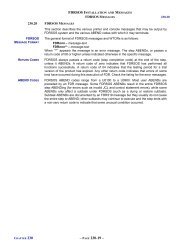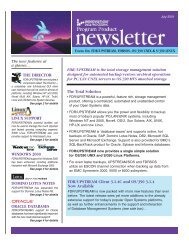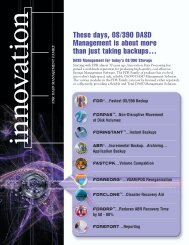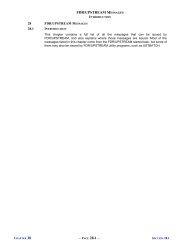FDR V54L78 - Innovation Data Processing
FDR V54L78 - Innovation Data Processing
FDR V54L78 - Innovation Data Processing
You also want an ePaper? Increase the reach of your titles
YUMPU automatically turns print PDFs into web optimized ePapers that Google loves.
MESSAGES AND CODES<br />
CHAPTER 100 – PAGE 100-59 –<br />
MESSAGES FROM <strong>FDR</strong>, DSF, AND ABR (<strong>FDR</strong>NNN) 100.3<br />
ALLOC LIST – From the ABR RESTORE ALLOCATION LIST.<br />
<strong>FDR</strong>304 type function REQUEST FOR DDNAME=dddddddd,VOL=SER=vvvvvv,UNIT=uuuuuu<br />
Reason: Describes the ABR operation that was performed.<br />
“type” is the type of operation and may be:<br />
<strong>FDR</strong> – Full Volume Backup/Restore.<br />
ABR – Incremental Volume Backup or data set restore from Volume Backup.<br />
DSF – Manual Backup/Restore by data set<br />
ARC – Archive Backup, Application Backup, or Restore data sets from either.<br />
SCR – Superscratch.<br />
“function” is DUMP or RESTORE. “dddddddd” is the DDname of the input disk (it may be<br />
DISKONLn if it was dynamically allocated by ABR). “vvvvvv” is the disk volume serial, and<br />
“uuuuuu” is the type and model of the disk as determined by ABR (e.g., 3390-3).<br />
<strong>FDR</strong>305<br />
Reason:<br />
<strong>FDR</strong>306<br />
Reason:<br />
direction TAPE DDNAME=dddddd,DSNAME=dsname,FILE=ffff,VOL=SER=vvvvvv,....<br />
Describes the backup data set used in an ABR Dump/Restore operation. The DDname<br />
(“dddddd”), data set name (“dsname”), tape file sequence number (“ffff” - 0 for disk),<br />
and disk or tape volsers are displayed. If over 5 volumes are involved, several lines<br />
are printed. “direction” is TO for backups and FROM for restores.<br />
function SUCCESSFULLY COMPLETED [WITH DIAGNOSTIC MESSAGES]<br />
The ABR operation described by the message has been completed. If the text “WITH<br />
DIAGNOSTIC MESSAGES” appears, the dump/restore subtask detected non-terminating<br />
error conditions; you should check the messages printed on SYSPRINx from the<br />
dump/restore subtask. “function” is DUMP, RESTORE, SIM, or SCRATCH.<br />
<strong>FDR</strong>307 TAPE UNCATALOGED DSN=nnn...nnn<br />
Reason: This ABR Volume Backup was a full-volume backup, so it started a new generation.<br />
Therefore, ABR uncataloged the backup tapes from all cycles of the nnn'th prior<br />
generation, where “nnn” is the number of generations to be retained for this disk<br />
volume, as recorded in the ABR Model DSCB on the volume (ISPF panel A.I.8),<br />
<strong>FDR</strong>308<br />
Reason:<br />
Action:<br />
CATALOG FAILURE FOR BACKUP COND CODE=cc [MAXIMUM VOLSERS EXCEEDED]<br />
A catalog request for an ABR backup data set has failed. “cc” is the catalog return code;<br />
common values are:<br />
8 – ABR backup data set is already cataloged. Since the name of this backup<br />
duplicates a previous backup, this backup may not be usable. Some<br />
possible causes are:<br />
The <strong>FDR</strong>ABRM REMODEL command (section 50) has been used incorrectly.<br />
<br />
<br />
A full volume RESTORE or COPY under <strong>FDR</strong> or <strong>FDR</strong>ABR has been done<br />
with VOLRESET=NO.<br />
A Stand Alone Restore (SAR) has been done.<br />
These operations can back-level the generation and cycle number. The REMODEL<br />
command of program <strong>FDR</strong>ABRM or the ABR ISPF dialogs can be used to update<br />
the model DSCB on the volume to the proper generation and cycle.<br />
For an application backup (<strong>FDR</strong>APPL), if the backup of the control file is a<br />
GDG, return code 8 can also occur if the GDG base has not been defined.<br />
20 – The ABR catalog is full. Once you have expanded or reorganized the<br />
catalog you can manually catalog the backup using the information in the<br />
<strong>FDR</strong>305 message.<br />
If the text “MAXIMUM VOLSERS EXCEEDED” appears a single ABR backup file has<br />
exceeded 20 tape volumes and cannot be cataloged. You may be able to reduce the<br />
number of volumes required by using higher-capacity tapes or using tape hardware<br />
compression (e.g., IDRC) or ABR software compression (COMPRESS=)<br />
If you cannot correct the error, contact INNOVATION DATA PROCESSING for assistance.



